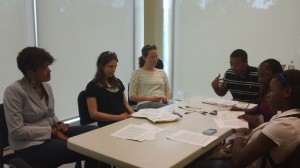Summer Program Update by Gretchen Barkhuff
 Author Dolen Perkins-Valdez stopped by the workshop this past Tuesday, July 24th, to discuss her short story, “The Clipping.” “The Clipping” explores the weight of memory as a haunting family past of a lynched ancestor bleeds into contemporary life through a newspaper clipping.
Author Dolen Perkins-Valdez stopped by the workshop this past Tuesday, July 24th, to discuss her short story, “The Clipping.” “The Clipping” explores the weight of memory as a haunting family past of a lynched ancestor bleeds into contemporary life through a newspaper clipping.
The students had a fantastic conversation with Perkins-Valdez, connecting the first conversation that they had with author Ralph Eubanks to Perkins-Valdez’s story. The students were torn over whether the violent family history should be passed down from generation to generation, or forgotten. Recalling Eubanks’ conversation on race, some of the students asserted that the family history would simply continue to stir racial animosity, preventing a more unified future. Others argued that it is important to understand all parts of your own story, including your family’s past.
Perkins-Valdez also expanded on last week’s dialogue conversation, providing useful tips to the students. She taught the students about dialogue subtext: a conversation can appear to be about one thing on the surface, but in reality there is a second conversation going on beneath it. The students laughed as Perkins-Valdez had them come up with a conversation discussing tea that really wasn’t about tea at all. One of the students, commenting on how Perkins-Valdez creates believable dialogue, asked how to convey tone such as sarcasm without simply adding in an adverb. Perkins-Valdez gave an answer that surprised the students: A great writer leaves room for readers to interpret dialogue. Giving the example of how Shakespeare’s Julius Caesar line “Et tu, Brute” has been performed in a variety of ways, Perkins-Valdez asserted that it is okay—even desirable—for different readers to read in different tones. Each reader will read a story in their own way, and good stories, Perkins-Valdez commented, allow for this to happen.
After Perkins-Valdez left, the students participated in another fun writing activity. Check back in the very near future to find out what it was and see examples of the students’ pieces. Hint: Crayons were involved!
